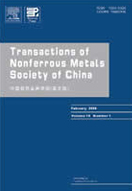Finite element analysis of stress at implant−bone interface of
dental implants with different structures
dental implants with different structures
(1. The Third Xiangya Hospital, Central South University, Changsha 410013, China;
2. State Key Laboratory of Powder Metallurgy, Central South University, Changsha 410083, China)
2. State Key Laboratory of Powder Metallurgy, Central South University, Changsha 410083, China)
Abstract: The effect of structure, elastic modulus and thickness of lower modulus layer in porous titanium implants on the stress distribution at the implant–bone interface was investigated. Three-dimensional finite element models of different titanium implants were constructed. The structures of the implants included the whole lower modulus style (No.1), bio-mimetic style (No.2), the whole lower modulus style in cancellous bone (No.3) and the whole dense style No.4. The stress distributions at bone–implant interface under static loading were analyzed using Ansys Workbench 10.0 software. The results indicated that the distribution of interface stress is strongly depended on the structure of the implants. The maximum stresses in cancellous bone and root region of implant No.2 are lower than those in the other three implants. A decrease in the modulus of the low modulus layer facilitates the interface stress transferring. Increasing the thickness of the low modulus layer can reduce the stress and induce a more uniform stress distribution at the interface. Among the four implants, biomimetic style implant No.2 is superior in transferring implant–bone interface stress to surrounding bones.
Key words: titanium implant; elastic modulus; finite element analysis; porous structure

